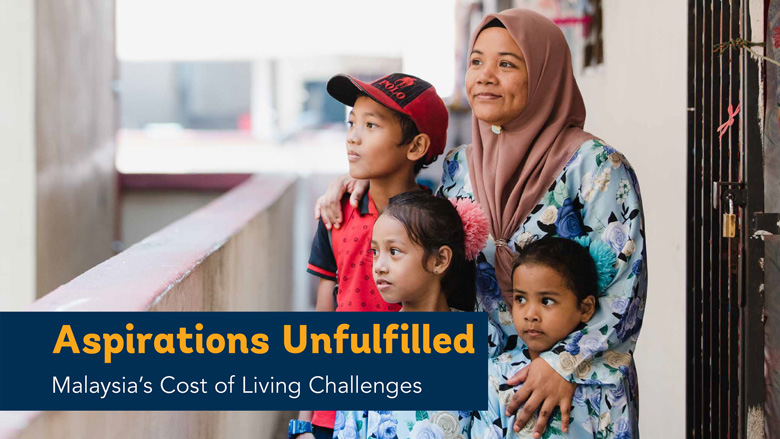In Malaysia, perceived increases in the cost of living have been a subject of ongoing debate and discussion, despite the country’s current period of low and stable inflation. Rather, the “cost of living” is frequently used as a catchall term that reflects wider impacts on household budgets and individual well-being beyond price increases. As such, concerns about the rising cost of living are influenced by several factors. These include:
Large differences in living costs across different parts of the country
- Housing prices have the most notable difference across states and urban/rural areas, but large price differences for food, clothing, services, and other necessities also exist across geographical locations.
- Johor, Kuala Lumpur and Selangor are the most high-cost states, with lower living costs in Kedah, Kelantan and Perlis.
Income growth not keeping up with Malaysians’ expectations
- Younger workers face stagnant growth in employment income despite rising education qualifications. Wage growth is also sluggish for those without higher education, regardless of age.
- Widening absolute income gaps between the bottom 40 percent and the top 20 percent of the income distribution have also furthered the sentiment of being left behind.
Low savings and heavy debt burdens
- A majority of households do not have adequate financial savings, and financial pressures are felt by most working adults regardless of age group and location.
- Debt among lower-income borrowers is mostly used to support consumption, either for motor vehicle or personal financing loans, rather than longer-term investments to accumulate wealth.
Deteriorating housing affordability in Klang Valley
- The supply of affordable housing does not meet demand in key urban areas such as Kuala Lumpur and Petaling District.
- The shortage of affordable housing is most severe for households earning between RM3,000-RM5,000 per month.
- Overcoming these challenges requires a mix of short-term measures to ease immediate cost of living pressures, coupled with longer-term structural reforms to boost market competition and increase incomes.
Short-term measures:
- The creation and timely reporting of an official Spatial Price Index (SPI) will help create policies to address price increases in different areas, providing better alignment to B40 consumption patterns.
- Expanding childcare services and flexible working arrangements for B40 families to make it easier for parents to participate in the labor force.
- Creating a repository of accessible financial planning tools for all.
- Adopting a more precise housing affordability measure, which considers location, housing supply and demand, instead of relying mostly on median incomes and home prices.
- Strengthening the rental market through a Rental Tenancy Act and Tribunal.
Medium and long-term measures:
- Realigning investment and hiring incentives toward high quality job creation.
- Expanding early childhood education and promoting life-long learning and upskilling.
- Strengthening consumer protection and encouraging more responsible behavior by banks and other financial institutions.
- Increasing financial incentives to encourage retirement savings.
- Prioritizing low- and middle-income households in housing policies and programs.
- Strengthening coordination across federal, state, and local governments in housing policies and planning.
